
Issue #: 155
Published: September / October 2017
- Price per issue - digital : 5.70€Digital magazine
- Price per issue - print : 7.70€Print magazine
- Access to Multihulls World digital archives Digital archives
At a village situated on the north coast of Pana Tinani, we were surprised to see a craft that was fishing for sharks with butchers’ hooks! But they only want the fins. I guessed that they did this while the sharks were still alive, as the sharks are quite lively. The sharks end up having a slow death whilst the fishermen only take the fins… The least that one can say is that it’s a horrible way to operate. However, with their primitive lifestyle, the sharks are seen as enemies of the villagers and their children. And they are also one of the few means of economic exchange for the local population. As ever, nothing is simply black and white. I ask one of them if I can see how they dry them. He takes me up on the roof of a dwelling where dozens of fins are drying, some of which must have come from 3 or 4 meter long sharks. Inside the house I see 2 large bags of fins waiting to be taken to Alotau by the schooner. Their clients are Japanese or Chinese. I feel that it’s these Asian consumers that we should be blaming, because in our not always pleasant world, it’s often the market which creates the demand for certain activities. A gentler, wiser view will lead us to happiness in a naturally preserved environment isn’t going to happen just yet. But we need to strive for it!
A little further west, I spotted on the map of Pana Wina Island, a bay at the end of which a stream ran, cutting the island in two. I guessed that it would be a favorite spot for the salties (saltwater crocodiles), and we wanted to see one in its natural environment. Without getting eaten if possible! We anchored in the bay and saw the houses of a Papuan family that was living there, completely isolated. There was a sailing dug-out canoe, two paddle canoes and three houses. I went ashore with our kayak to say hello to them. The man lived there with his sick wife. One of their daughters came regularly from one of the local villages to spend a few hours there each day and help out. She walked along the shore at low tide. That was several hours of walking… We saw very few old people on the Louisiades : it’s fairly clear that life expectancy is short, not necessarily because of their lifestyle, but more through the lack of healthcare throughout their lives. The man confirmed that there were crocodiles in the stream, but that access was very difficult, and the crocs prefer to come into the open water at night, when the water in the bay is calm. We did go on a very prudent hunt along a bank, with our sticks in our hands, ready to hit out, but the salties of Pana Wina stayed hidden in the mangroves.
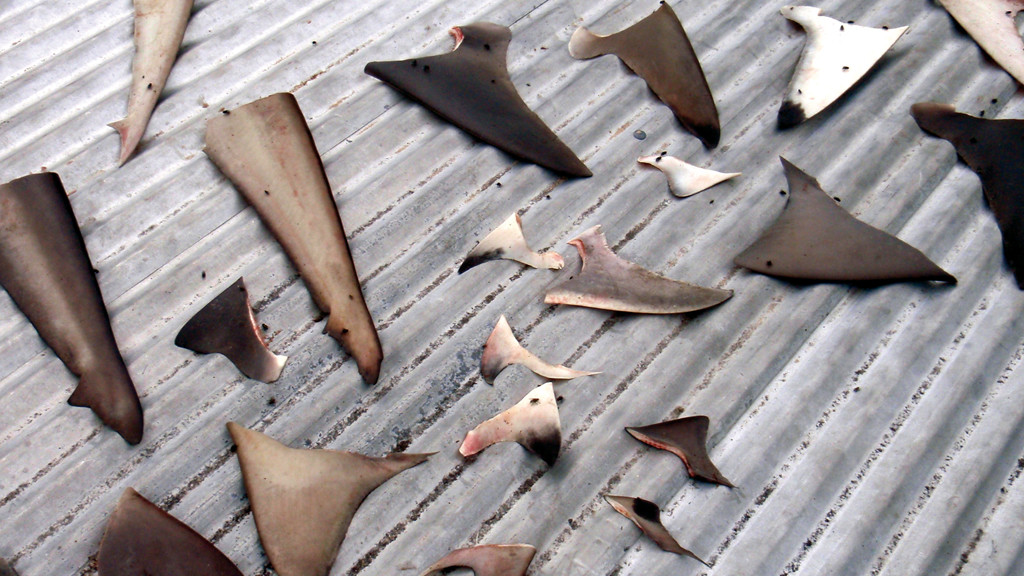
We sailed alongside Gigila Island, passing small coastal villages, and anchored in Robinson Harbour, close to the small island of Talfaur, which is linked to Gigila by a sandy isthmus, which covers at high tide. We were welcomed very warmly on Talfaur, thanks to the family of Ronnie, who just happens to be the village chief. Ronnie is around 30 and is very affable and speaks good English. He is interested in everything. He explained how he went to get his young wife on Misima, the large island that is close by, and how he had to work for months for his father in law before he was able to bring his bride back to his village in the lagoon… Ronnie took us to the gardens that they cultivate on the other side of the isthmus, and he sent a child up a coconut palm to offer us a refreshing drink. On the way back, we went to see the source which provides the villagers with fresh water. Ronnie is never without his 3 year old son, who came everywhere with us.
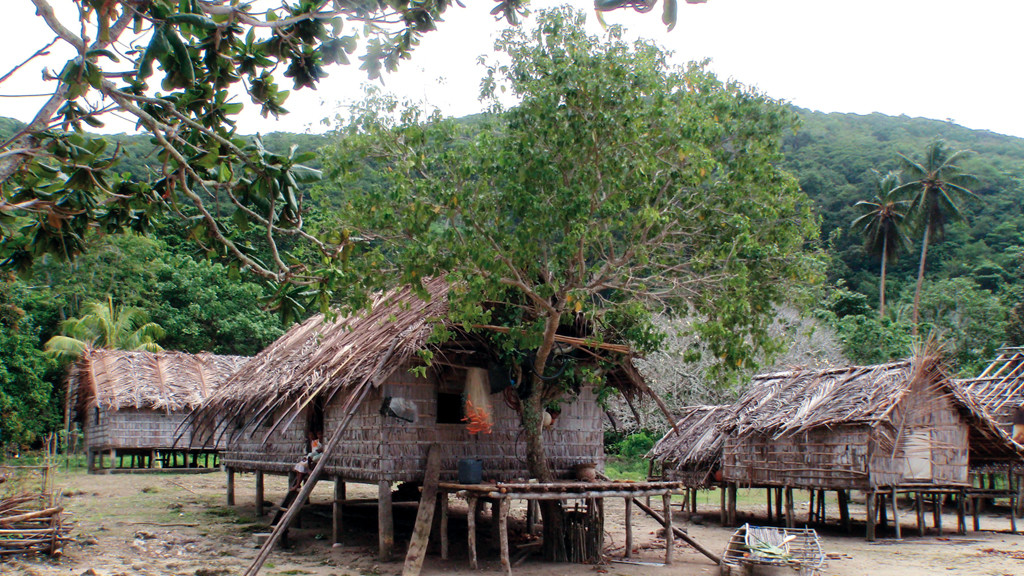
Dans sa case, le chef me montre une installation électrique basique donnée par une association de bienfaisance australienne. Un équipement que nous retrouverons aussi dans d’autres villages : un panneau solaire, un régulateur, une batterie, un néon. Les villages des Louisiades sont bien sûr noyés dans l’obscurité dès que la nuit tombe, vers 18h00. Pas de groupe électrogène, encore moins de réseau ! Le feu couve dans les foyers, entretenu, et il est attisé avant chaque repas. Lorsque c’est nécessaire, les Papous frottent des morceaux de bois sec pour obtenir une flamme. Ronnie me montre le néon, en panne. Le manque de réalisme technique et logistique de certaines ONG caritatives m’étonnera toujours. Fournir la lumière à une case papoue des Louisiades, cela relève en principe d’une bonne idée, certes. Encore que je ne sois pas totalement certain que ce soit une bonne idée, même si l’intention de départ est bonne. Le débat est en effet plus compliqué qu’il n’en a l’air. Ce serait un bon sujet de philosophie au baccalauréat. Mais la fournir avec un seul tube néon merdique, et aucune pièce de rechange, ça, c’est certainement une erreur grossière… J’observe le panneau, le régulateur, la batterie : du matériel de qualité. Mais le seul tube néon fourni est une saloperie à 3 sous…. Quand le tube néon est mort, plus rien ne marche, panneau et batterie high-tech sont désespérément inutiles. J’y vois l’occasion de faire un exercice formateur pour mes enfants, en même temps que de rendre un petit service au village. J’explique à mes enfants le manque de logique technique associé au geste de cette association caritative, bien intentionnée mais peu pragmatique, qui dépose un matin en vrac sur la plage d’un petit village perdu des Louisiades du matériel dont l’usage est inconnu des insulaires, sans veiller à l’installer correctement elle-même, et sans en donner le mode d’emploi adéquat. Et sans laisser la moindre pièce de rechange. La pérennité de la transmission technologique doit être un objectif principal, selon moi. De notre bord, avec les garçons, je ramène notre caisse à outils, mon multimètre, des cosses électriques. Nous entreprenons de faire dans la case de Ronnie un montage fixe, qui doit pouvoir durer. J’en explique les raisons au chef du village, que je vois manipuler sans ménagement le panneau solaire resté mobile, avec son câble volant… Seul problème : le panneau et la batterie sont en 12 volts, et l’installation de Jangada est en 24 volts. Je n’ai donc pas grand-chose qui convient. En fouillant dans mes propres pièces de rechange, je trouve néanmoins une ampoule 12 volts de rechange pour la petite lampe de cockpit confectionnée dans le delta du Saloum au Sénégal, à partir d’une calebasse et d’une douille de phare de voiture récupérée dans une casse africaine. Je n’ai pas d’autre douille pour recevoir l’ampoule, alors j’explique à Ronnie que je vais souder les fils à l’étain directement sur le culot. A bord, Adélie, qui aime l’odeur de l’étain en fusion, m’aide à effectuer le travail. J’adore bricoler avec mes enfants, je peux leur apprendre des trucs qui leur seront utiles tout au long de leur vie !
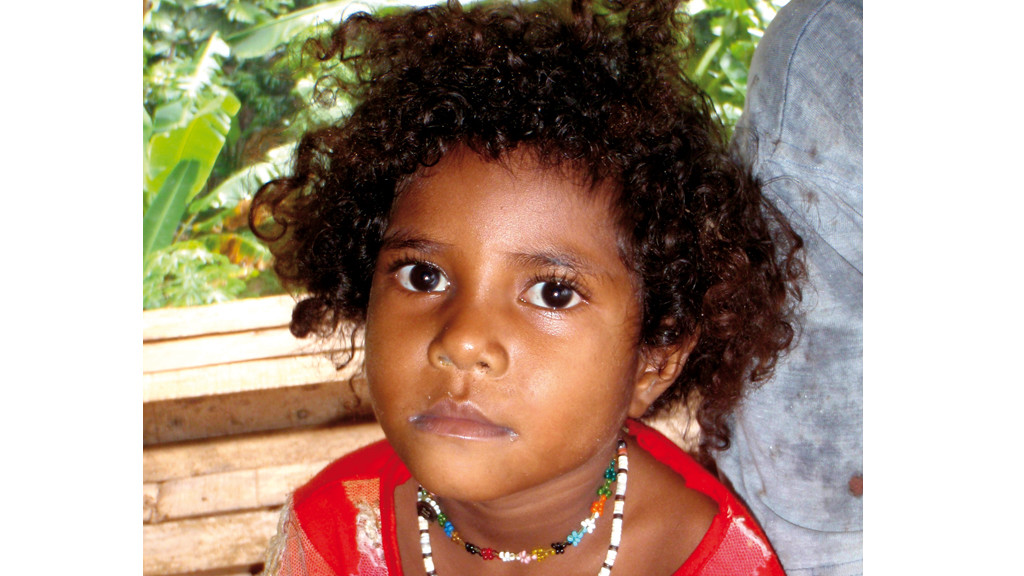
In his home, the chief showed me a basic electrical installation that had been given to him by an Australian charity. It was something that we had seen in other villages: a solar panel, a regulator, a battery and a neon light. The Louisiades villages are of course plunged into darkness when night falls at around 6pm. There are no generators and there is definitely no electricity network! There is a fire in each home, which is stoked up before each meal. When needed, the Papuans will rub dry sticks together to start a fire. Ronnie showed me the broken neon light. The lack of technical and logistical know-how of some charitable NGOs, will forever amaze me. To offer lighting to a home in the Louisiades is probably a good idea, although I’m not completely convinced. It’s a more complicated question than it appears. It would be a good exam question for a student. But whatever the case, to supply a poor quality neon light and no spare parts is without doubt a big mistake. The solar panel, the regulator and the battery are all good quality. But the only neon tube which is supplied is a cheap piece of garbage. When the neon tube doesn’t work, nothing works. The panel and the high tech battery are useless. I spot an opportunity to teach a lesson to my kids, and to help out the village at the same time. I explain to the kids the lack of technical logic involved in the charitable organization’s work, despite being well-intentioned. One morning they drop off a load of stuff on a remote Louisiades island. The villagers don’t know how it works, it isn’t installed properly, and there is no manual to explain it all. And there are no spare parts. The passing on of technical know-how should be of the highest importance in my opinion. From our boat, the boys and I brought the tool kit, a multimeter and some cable lugs. We tried to set up a fixed installation in Ronnie’s house. One which would stand the test of time. I explain what I am doing to Ronnie, who is messing around with the solar panel and its cable. The only problem that we have is that the battery is 12V and Jangada’s electrical installation is 24V. So I don’t have much that can be useful. In my bits and pieces I found a spare 12V lightbulb which we used for the cockpit lamp that we put together in the Saloum Delta in Senegal, with a calabash and a lamp holder that we found in an African scrapyard. I didn’t have another lamp holder for the bulb, so I explained to Ronnie that I was going to solder the wires to the tin on the lower part. On board, Amélie loves the smell of the tin being soldered, and she helps me to do it. I love doing DIY with the kids. I feel as though I can teach them things that will be useful for the rest of their lives!
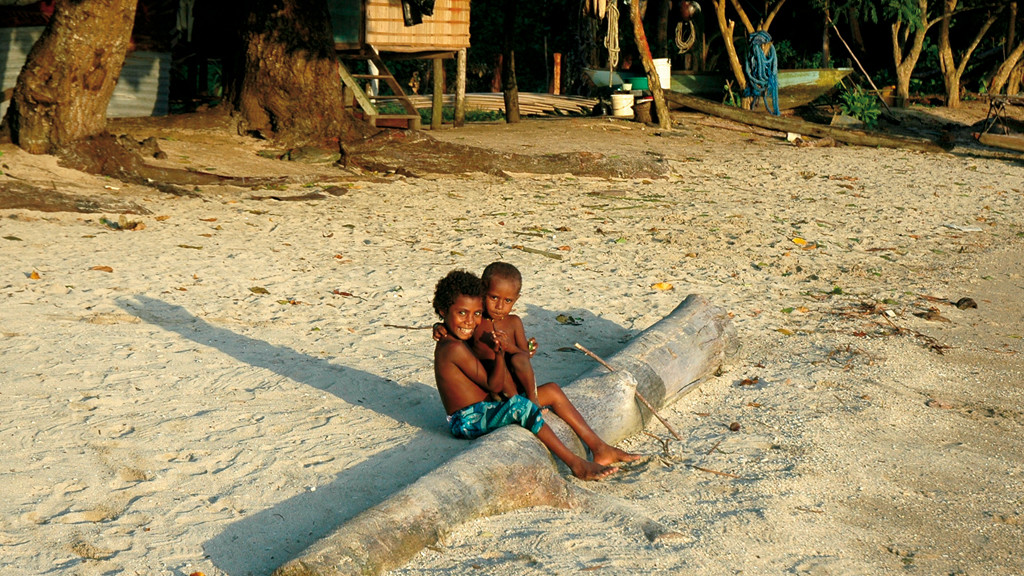
The next morning the crew of Jangada embarked upon a major technical operation on dry land! All the village children were there to watch as well as the men and also a few women in the background. I feel as though I am carrying the whole of western technology on my shoulders! I ask Ronnie where he would like the small bulb to be positioned in his house. Then, with Timothée and Marin, we hoisted the battery to just below the roof and attached it solidly with rope from the boat. We then run the cable from the battery neatly through the roof’s wooden framework and palms to the solar panel. We then fixed the cable that took the current from the battery to the light bulb. Plastic ties kept everything in place. There I was, a technology teacher out in the bush! I installed a neat light switch, checked our work, made sure it was spot on, and when I was happy, pressed the light switch. The bulb lit up. Everyone shouted out. They were all happy! The set up should last as it is securely installed, and the only thing that the villagers will need to do is flick the switch. I explained to Ronnie how each element of the set-up worked, and gave him a few tips. I also told him that the first thing that would give up would be the light bulb. He would need to get another one the next time that there would be a passing yacht. It’s the only way to keep the system going. Ronnie fully understood.
The chief also showed me his dugout canoe which was pulled up on the sand. On the outside layer around the bottom of the keel, there was an area which was rotten, and taking on water. We had a closer look. It wasn’t too serious, and I suggested to Ronnie that we cover it with a piece of screwed on plywood sealed with silicon. I brought over the correct stainless steel screws, a Philips head screwdriver and a cartridge of silicon. However, given that this was such an important piece of equipment, Ronnie decided to go into the forest to find a piece of wood that was of better quality and would ensure a longer-lasting job. I don’t think that my piece of plywood inspired him particularly. It was clear that the pirogue had been taking on the water of the Louisiades lagoon for some time, and I was just happy to help. I sometimes think about that little 12V light bulb: probably the only one in the village of Talfaur island, shining as night falls… But for how much longer?
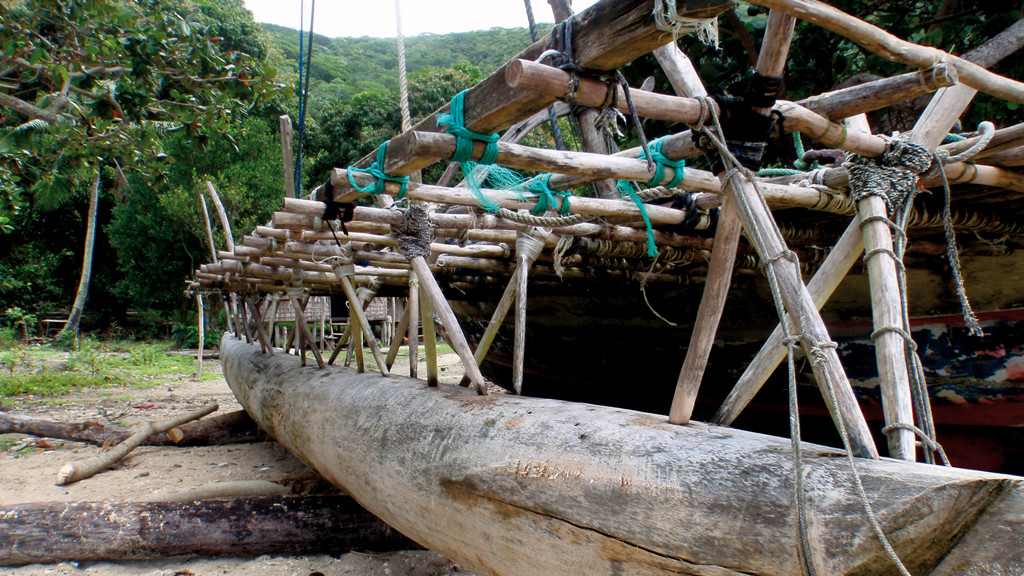
In the meantime, there was plenty of bartering going on in Robinson Harbour. If you ever go to the Louisiades, remember to take plenty of things with you. Bartering is such a pleasant kind of commerce! It’s also the perfect opportunity to get rid of some stuff from your boat, and to tidy things up at the same time. In exchange for sweet potatoes, yams, taros, beans, bananas, limes, coconuts, oranges and even langoustines, we give (in a fair, well-thought through way), pens, notebooks, books, school books, clothes, sugar, rice, washing powder and soaps. For the men, the must have items are fishing hooks, diving masks, snorkels and rope. It’s a chance to get rid of everything in the boat which isn’t indispensable! We stayed for a few days anchored off the village of Talfaur. We went fishing for langoustines around the small island of Einamu, shared out the fish that we caught and let the village children play with our kites, inherited from the La Tortue, shipwrecked on the island of Kelefesia in the Ha’apai islands. We even tried to go with Ronnie to the neighboring island of Pana Krusima where he had spent his youth. He wanted to show us the salties which live in the small island’s lagoon. However, the salties didn’t want to play and stayed in the shade of the mangroves.
On our last night, Ronnie’s younger brother captured and killed a black pig. The men roasted it over the fire and the women prepared all the vegetable dishes: yams, taros and sweet potatoes. All five of us were invited to dinner in Ronnie’s house. The villagers had got their best plates out for us, and even cutlery which they must have recuperated from a passing boat. We sat on mats, and Ronnie and the female members of the family had put on their best clothes. Everyone was in high spirits. At ceiling level, the little lightbulb was shining brightly. Under the house’s floor, and between the stilts, a group of pigs was noisily making the most of the few rays of light that filtered through the bamboo. Unless they were there to salute the passing of their comrade who had just been chopped up into tasty morsels…
This was a happy, sharing moment on the far side of the world!
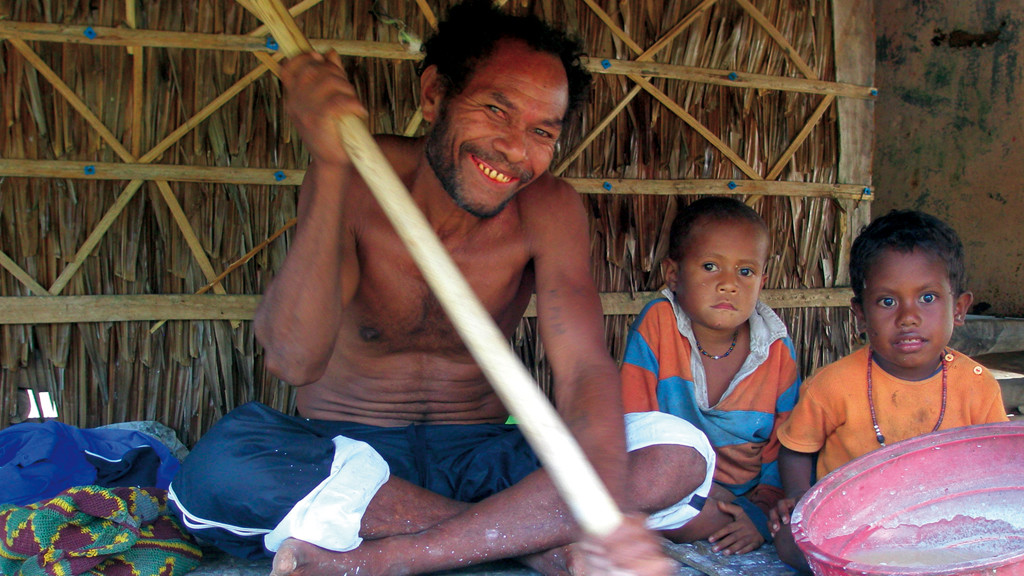
The next morning at daybreak, Jangada headed west towards Pana Numara and an isolated mooring between Bobo Eina and the Gilia Islands and also Bagaman Island with its two large, protected bays. Our last hours in the great lagoon of the Louisiades were spent surrounded by the magnificent scenery of the small turquoise lagoon of Panasia Island. It was a lagoon within a lagoon (I’d never seen this before in the Pacific). It had its own channel which meant going up into the spreaders to be able to spot exactly where you needed to go. We slalomed between the coral heads and found our way to a solid anchorage at the foot of a rocky cliff which dropped into clear waters. There were no dwellings on this side of Panasia, just banana and papaya gardens cultivated by a family which lived on the other side of the hill, and who got there via canoe. The boys fished in the lagoon while the girls swam along a small beach with glistening sand. We went to visit the deserted “motu” of nasakoli in the dinghy, from where Barbara and I brought back wonderfully scented Plumeria flowers.
We are at the end of our trip to the archipelago, and for the last 48 hours I have been following the weather maps as we head for Port Moresby, where Timothée will take a plane back to France. We leave on the morning of the 20th June.
Farewell happy islands on the other side of the world…
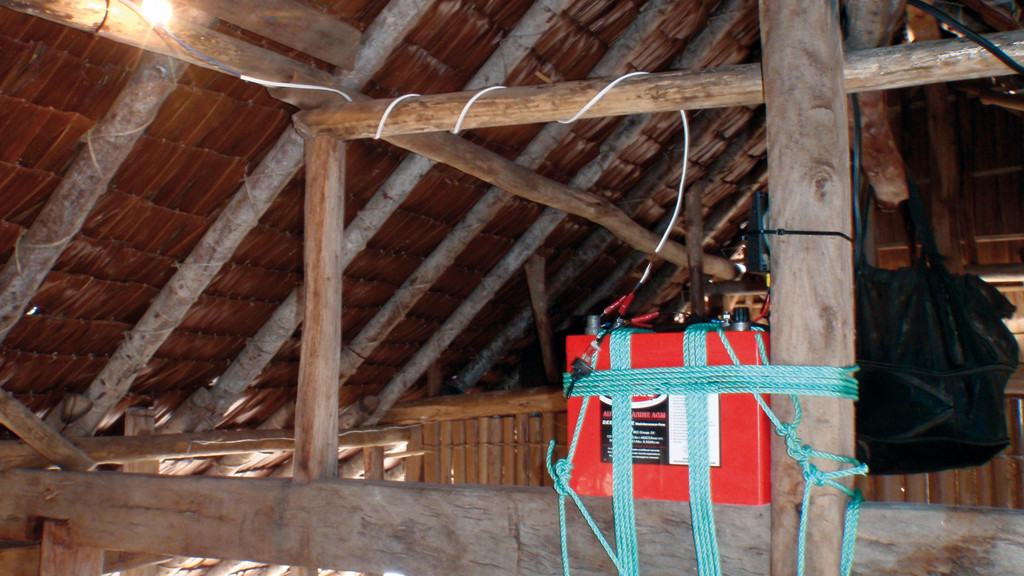
What readers think
Post a comment
No comments to show.